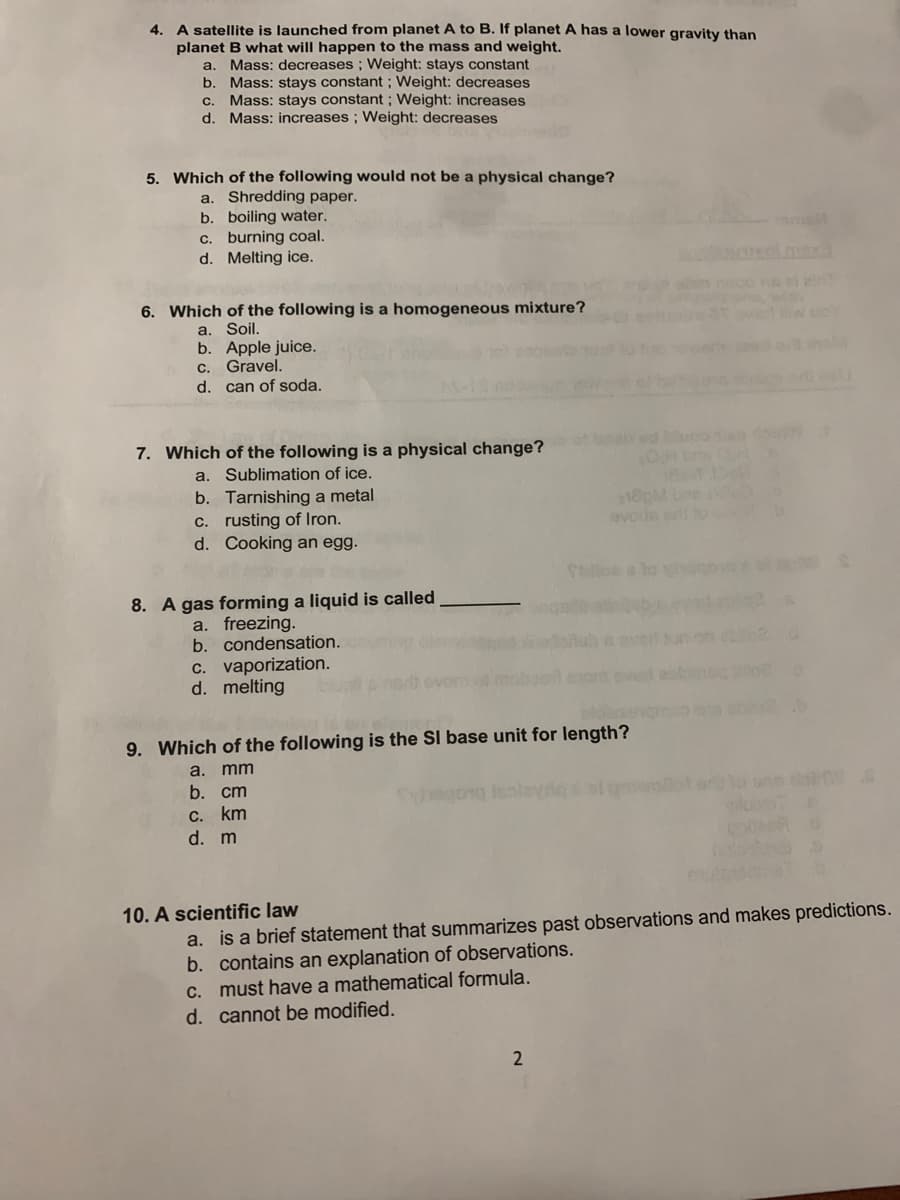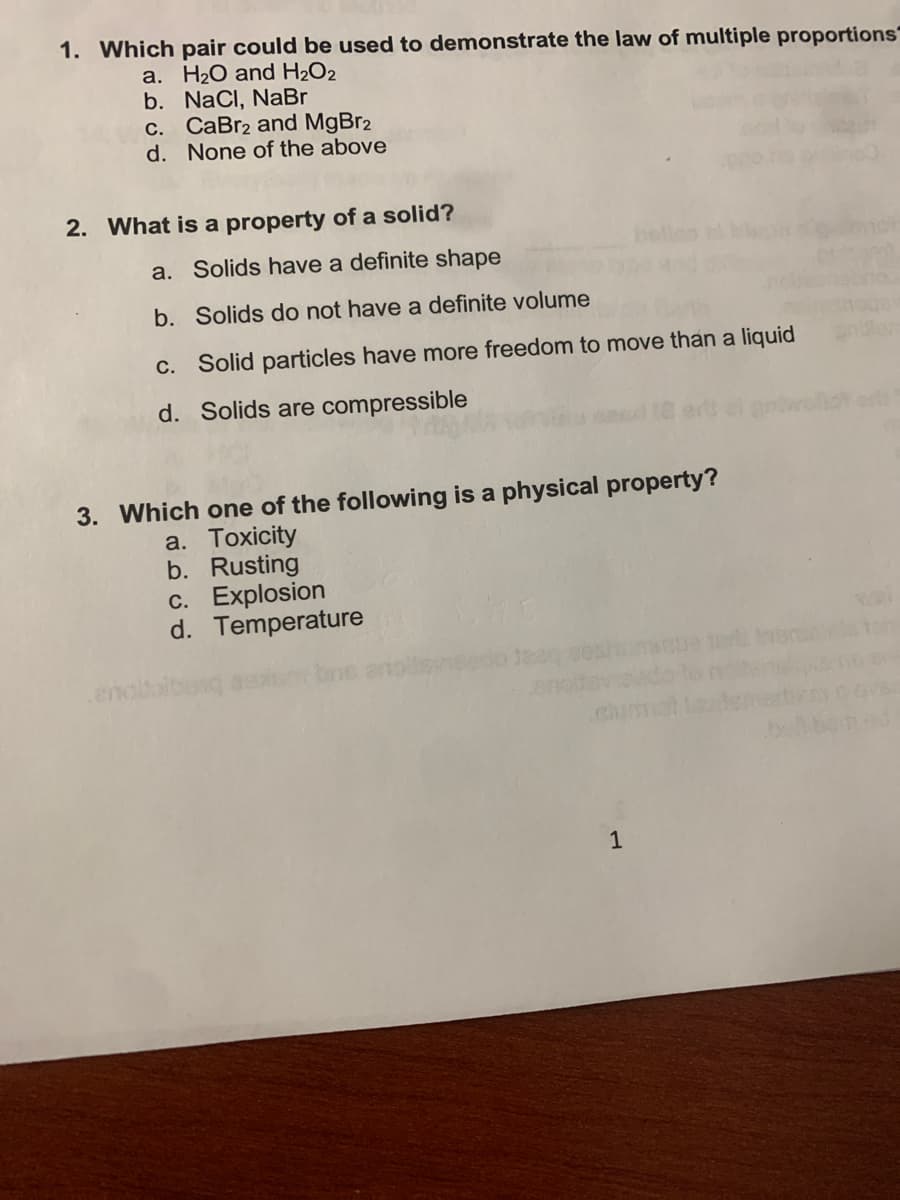4. A satellite is launched from planet A to B. If planet A has a lower gravity than planet B what will happen to the mass and weight. Mass: decreases; Weight: stays constant b. Mass: stays constant; Weight: decreases c. Mass: stays constant; Weight: increases d. Mass: increases; Weight: decreases a. 5. Which of the following would not be a physical change? a. Shredding paper. b. boiling water. c. burning coal. d. Melting ice. 6. Which of the following is a homogeneous mixture? a. Soil. b. Apple juice. C. Gravel. d. can of soda. 7. Which of the following is a physical change? a. Sublimation of ice. BA b. Tarnishing a metal C. rusting of Iron. d. Cooking an egg. avor ad to Sblloe s to vihono 8. A gas forming a liquid is called a. freezing. b. condensation. c. vaporization. d. melting 9. Which of the following is the SI base unit for length? a. mm b. cm C. km d. m 10. A scientific law a. is a brief statement that summarizes past observations and makes predictions. b. contains an explanation of observations. C. must have a mathematical formula. d. cannot be modified.
4. A satellite is launched from planet A to B. If planet A has a lower gravity than planet B what will happen to the mass and weight. Mass: decreases; Weight: stays constant b. Mass: stays constant; Weight: decreases c. Mass: stays constant; Weight: increases d. Mass: increases; Weight: decreases a. 5. Which of the following would not be a physical change? a. Shredding paper. b. boiling water. c. burning coal. d. Melting ice. 6. Which of the following is a homogeneous mixture? a. Soil. b. Apple juice. C. Gravel. d. can of soda. 7. Which of the following is a physical change? a. Sublimation of ice. BA b. Tarnishing a metal C. rusting of Iron. d. Cooking an egg. avor ad to Sblloe s to vihono 8. A gas forming a liquid is called a. freezing. b. condensation. c. vaporization. d. melting 9. Which of the following is the SI base unit for length? a. mm b. cm C. km d. m 10. A scientific law a. is a brief statement that summarizes past observations and makes predictions. b. contains an explanation of observations. C. must have a mathematical formula. d. cannot be modified.
Chapter1: Matter, Measurements, And Calculations
Section: Chapter Questions
Problem 1.12E
Related questions
Question

Transcribed Image Text:4. A satellite is launched from planet A to B. If planet A has a lower gravity than
planet B what will happen to the mass and weight.
a. Mass: decreases ; Weight: stays constant
b. Mass: stays constant ; Weight: decreases
Mass: stays constant ; Weight: increases
d. Mass: increases ; Weight: decreases
C.
5. Which of the following would not be a physical change?
a. Shredding paper.
b. boiling water.
c. burning coal.
d. Melting ice.
6. Which of the following is a homogeneous mixture?
a. Soil.
b. Apple juice.
C. Gravel.
d. can of soda.
7. Which of the following is a physical change?
a. Sublimation of ice.
b. Tarnishing a metal
c. rusting of Iron.
d. Cooking an egg.
avods e to
olloe a to vio
8. A gas forming a liquid is called
a. freezing.
b. condensation.
c. vaporization.
d. melting
Rab a aver
9. Which of the following is the SI base unit for length?
a. mm
b. cт
с. km
d. m
ane do
10. A scientific law
a. is a brief statement that summarizes past observations and makes predictions.
b. contains an explanation of observations.
C. must have a mathematical formula.
d. cannot be modified.

Transcribed Image Text:1. Which pair could be used to demonstrate the law of multiple proportions
a. H2O and H2O2
b. NaCl, NaBr
c. CaBr2 and MgBr2
d. None of the above
2. What is a property of a solid?
a. Solids have a definite shape
b. Solids do not have a definite volume
C. Solid particles have more freedom to move than a liquid
d. Solids are compressible
3. Which one of the following is a physical property?
a. Toxicity
b. Rusting
c. Explosion
d. Temperature
ch
1
Expert Solution
This question has been solved!
Explore an expertly crafted, step-by-step solution for a thorough understanding of key concepts.
Step by step
Solved in 2 steps with 2 images

Knowledge Booster
Learn more about
Need a deep-dive on the concept behind this application? Look no further. Learn more about this topic, chemistry and related others by exploring similar questions and additional content below.Recommended textbooks for you


Chemistry: Matter and Change
Chemistry
ISBN:
9780078746376
Author:
Dinah Zike, Laurel Dingrando, Nicholas Hainen, Cheryl Wistrom
Publisher:
Glencoe/McGraw-Hill School Pub Co

Chemistry for Engineering Students
Chemistry
ISBN:
9781337398909
Author:
Lawrence S. Brown, Tom Holme
Publisher:
Cengage Learning


Chemistry: Matter and Change
Chemistry
ISBN:
9780078746376
Author:
Dinah Zike, Laurel Dingrando, Nicholas Hainen, Cheryl Wistrom
Publisher:
Glencoe/McGraw-Hill School Pub Co

Chemistry for Engineering Students
Chemistry
ISBN:
9781337398909
Author:
Lawrence S. Brown, Tom Holme
Publisher:
Cengage Learning

Chemistry: The Molecular Science
Chemistry
ISBN:
9781285199047
Author:
John W. Moore, Conrad L. Stanitski
Publisher:
Cengage Learning

Chemistry & Chemical Reactivity
Chemistry
ISBN:
9781337399074
Author:
John C. Kotz, Paul M. Treichel, John Townsend, David Treichel
Publisher:
Cengage Learning

World of Chemistry, 3rd edition
Chemistry
ISBN:
9781133109655
Author:
Steven S. Zumdahl, Susan L. Zumdahl, Donald J. DeCoste
Publisher:
Brooks / Cole / Cengage Learning